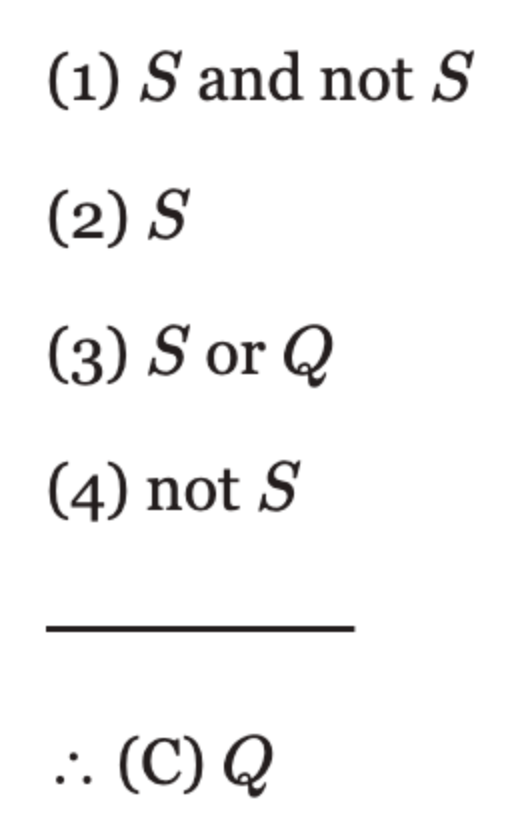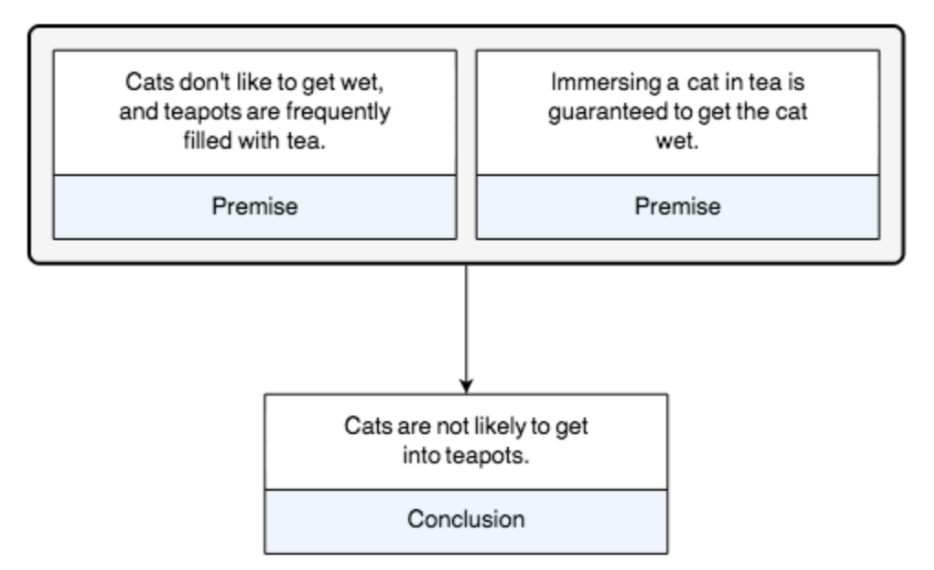
OLI - 1. Statements and arguments
Logic is the study of principles of correct reasoning.
Logic is interested in the kind of arguments one gives as a reason for accepting the truth of some particular claim.
Arguments are pervasive in every aspect of human life.
The logician is not interested in the subject matter of the argument, rather argument itself, the pattern of reasoning that it embodies.
Statements
The conclusion of the argument: the particular claim that an argument is for.
The whole purpose of an argument is to provide a reason for accepting the truth of its conclusion
Statement: something that has to be either true or false, and can't be both.
The same statement can be expressed by many different sentences.
Ej: I have been here before, It's not the first time I've been here, He estado aquí antes.
Other types of sentences
Declarative: statements.
Indexical: might be true while others are false depending on who utters the sentence, and when and where.
Ambiguous: a single sentence can be associated with multiple statements
Non-declarative: can't be considered true or false. Interrogative, imperative and exclamations.
Premises and conclusions
Premises: set of statements, the reason for accepting the truth of the conclusion.
The argument is made up of premises and a conclusion.
To identify the conclusion: what claim is the argument's presenter trying to convince you is true?
To identify the premise: what support is the argument's presenter providing for the truth of the conclusion?
An explanation simply provides information, it doesn't attempt to establish the truth of a statement.
A definition defines a word or phrase.
A description provides a mental image of the object or situation being described.
Determine what the passage is doing to know if it is an argument or just an explanation.
An argument will try to persuade.
Rethorical questions and imperatives may sometimes pose as an argument.
Identifying conclusions and premises
If there is one statement that the author of an argument is going to distinguish as being special, it is the conclusion.
To identify a conclusion:
Sometimes the author may explicitly state the conclusion.
They are often stated first and/or last.
May be indicated via conclusion indicator words
therefore
thus
hence
so
consequently
as a result
it follows that
this shows/indicates/means/implies that
Identify all the premises, and the statement left will be the conclusion.
To identify a premise:
Identify the conclusion, and everything else will be a premise.
Indicator phrases like
consider that
take as evidence that
it is evident that
it is a fact that
recall that
Premise as clause indicators
since
because
for the reason that
as
inasmuch as
as indicated by
Arguments in standard form
Standard form of an argument: write out all the premises first, then separate the conclusion by drawing a line and setting the symbol ∴ (therefore).
Example:

Why premises and conclusions aren't enough
What makes an argument a good argument
The premises should be true
Valid: any argument where the truth of the premises makes it impossible for the conclusion to be false
Inductively strong: an argument where the truth of the premises does not guarantee the truth of the conclusion, but rather makes it highly probably to be true
The premises of the argument should actually support the truth of the conclusion
Sound: arguments that are valid and have true premises
Cogent: arguments that are strong and have true premises
Not all valid/strong arguments are sound/cogent (since some or all of their premises could be false), but any sound/cogent argument is necessarily valid/strong.
Symbolic or formal logic
The structure of an argument crucially involves the logical structures of the premises and conclusion, as well as the pattern of relationships that hold between them.
The content of statements is of no consequence for (logical) arguments.

Each step of the argument is a fundamental pattern or rule of inference that can be applied any time we deal with sentences of the appropriate form.
Proofs
Proof: an argument that demonstrates its conclusion by a series of logical steps.
Argument diagramming
Argument diagrams allow us to represent more than just premises and conclusions.

Each premise is independent, together (joint) they support the conclusion.
Summary
Chapter overview, including an introductory movie and a statement of the learning objectives for the chapter ahead.
Declarative sentences express statements, which can be either true or false. Statements are the pieces out of which arguments are constructed.
Arguments consist of premises and a conclusion, each of which is a statement. Non-arguments have neither premises nor conclusion.
We discuss various techniques, including the use of particular words and phrases, for indicating that a particular sentence is the conclusion of an argument. As with conclusions, various techniques, including specific words and phrases, indicate that a particular sentence serves as a premise of an argument. Also considered are premises and conclusions that appear as clauses within the same sentence.
Arguments can be presented in a standard form that clearly indicates what the premises and conclusion of the argument are.
First, the criteria by which an argument may be considered good or bad are discussed. With that done, examples are compared to illustrate why representing an argument as just a set of premises and conclusion isn't enough to allow a reasonable logical analysis of the argument, and what we need to add to address this deficiency is discussed.
The motivation for adopting a symbolic approach to logic is discussed.
Two interesting and historically important proofs are presented as an illustration of the intricate structure an argument can have.
Argument diagrams are introduced as an alternative to standard form for representing arguments. Premises can provide support for a conclusion either jointly or independently; the technique for reflecting these differences in argument diagrams is discussed.
New terms
argument | conclusion | statement | premise | conclusion |
|---|---|---|---|---|
premise | explanation | definition | standard form | valid |
inductively strong | sound | cogent | invalid | argument diagrams |
OLI - 1. Statements and arguments
Logic is the study of principles of correct reasoning.
Logic is interested in the kind of arguments one gives as a reason for accepting the truth of some particular claim.
Arguments are pervasive in every aspect of human life.
The logician is not interested in the subject matter of the argument, rather argument itself, the pattern of reasoning that it embodies.
Statements
The conclusion of the argument: the particular claim that an argument is for.
The whole purpose of an argument is to provide a reason for accepting the truth of its conclusion
Statement: something that has to be either true or false, and can't be both.
The same statement can be expressed by many different sentences.
Ej: I have been here before, It's not the first time I've been here, He estado aquí antes.
Other types of sentences
Declarative: statements.
Indexical: might be true while others are false depending on who utters the sentence, and when and where.
Ambiguous: a single sentence can be associated with multiple statements
Non-declarative: can't be considered true or false. Interrogative, imperative and exclamations.
Premises and conclusions
Premises: set of statements, the reason for accepting the truth of the conclusion.
The argument is made up of premises and a conclusion.
To identify the conclusion: what claim is the argument's presenter trying to convince you is true?
To identify the premise: what support is the argument's presenter providing for the truth of the conclusion?
An explanation simply provides information, it doesn't attempt to establish the truth of a statement.
A definition defines a word or phrase.
A description provides a mental image of the object or situation being described.
Determine what the passage is doing to know if it is an argument or just an explanation.
An argument will try to persuade.
Rethorical questions and imperatives may sometimes pose as an argument.
Identifying conclusions and premises
If there is one statement that the author of an argument is going to distinguish as being special, it is the conclusion.
To identify a conclusion:
Sometimes the author may explicitly state the conclusion.
They are often stated first and/or last.
May be indicated via conclusion indicator words
therefore
thus
hence
so
consequently
as a result
it follows that
this shows/indicates/means/implies that
Identify all the premises, and the statement left will be the conclusion.
To identify a premise:
Identify the conclusion, and everything else will be a premise.
Indicator phrases like
consider that
take as evidence that
it is evident that
it is a fact that
recall that
Premise as clause indicators
since
because
for the reason that
as
inasmuch as
as indicated by
Arguments in standard form
Standard form of an argument: write out all the premises first, then separate the conclusion by drawing a line and setting the symbol ∴ (therefore).
Example:

Why premises and conclusions aren't enough
What makes an argument a good argument
The premises should be true
Valid: any argument where the truth of the premises makes it impossible for the conclusion to be false
Inductively strong: an argument where the truth of the premises does not guarantee the truth of the conclusion, but rather makes it highly probably to be true
The premises of the argument should actually support the truth of the conclusion
Sound: arguments that are valid and have true premises
Cogent: arguments that are strong and have true premises
Not all valid/strong arguments are sound/cogent (since some or all of their premises could be false), but any sound/cogent argument is necessarily valid/strong.
Symbolic or formal logic
The structure of an argument crucially involves the logical structures of the premises and conclusion, as well as the pattern of relationships that hold between them.
The content of statements is of no consequence for (logical) arguments.

Each step of the argument is a fundamental pattern or rule of inference that can be applied any time we deal with sentences of the appropriate form.
Proofs
Proof: an argument that demonstrates its conclusion by a series of logical steps.
Argument diagramming
Argument diagrams allow us to represent more than just premises and conclusions.

Each premise is independent, together (joint) they support the conclusion.
Summary
Chapter overview, including an introductory movie and a statement of the learning objectives for the chapter ahead.
Declarative sentences express statements, which can be either true or false. Statements are the pieces out of which arguments are constructed.
Arguments consist of premises and a conclusion, each of which is a statement. Non-arguments have neither premises nor conclusion.
We discuss various techniques, including the use of particular words and phrases, for indicating that a particular sentence is the conclusion of an argument. As with conclusions, various techniques, including specific words and phrases, indicate that a particular sentence serves as a premise of an argument. Also considered are premises and conclusions that appear as clauses within the same sentence.
Arguments can be presented in a standard form that clearly indicates what the premises and conclusion of the argument are.
First, the criteria by which an argument may be considered good or bad are discussed. With that done, examples are compared to illustrate why representing an argument as just a set of premises and conclusion isn't enough to allow a reasonable logical analysis of the argument, and what we need to add to address this deficiency is discussed.
The motivation for adopting a symbolic approach to logic is discussed.
Two interesting and historically important proofs are presented as an illustration of the intricate structure an argument can have.
Argument diagrams are introduced as an alternative to standard form for representing arguments. Premises can provide support for a conclusion either jointly or independently; the technique for reflecting these differences in argument diagrams is discussed.
New terms
argument | conclusion | statement | premise | conclusion |
|---|---|---|---|---|
premise | explanation | definition | standard form | valid |
inductively strong | sound | cogent | invalid | argument diagrams |
 Knowt
Knowt
